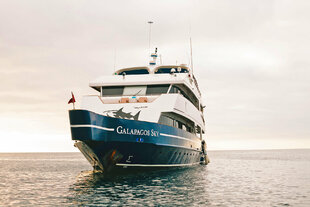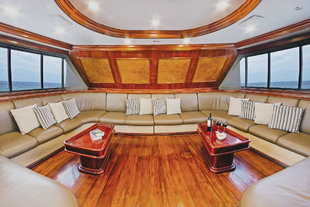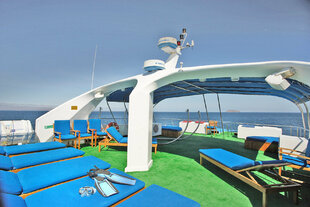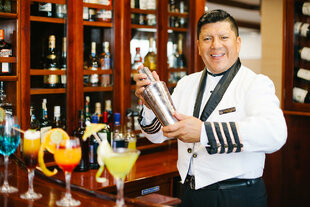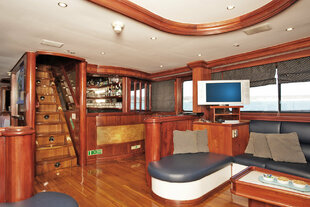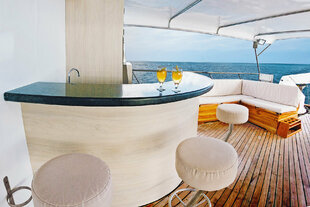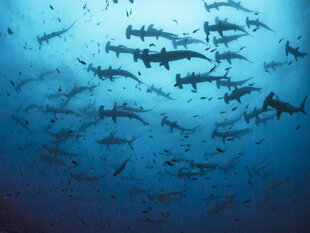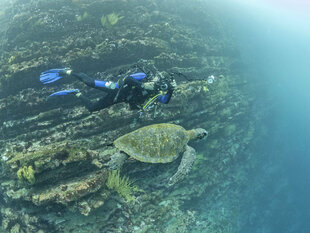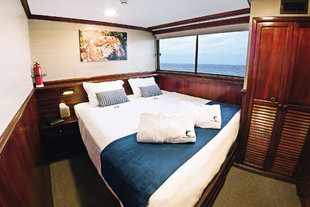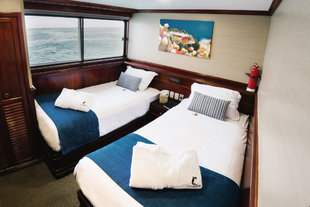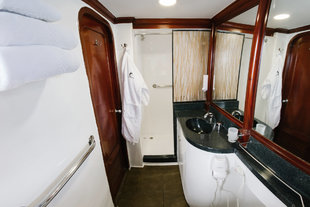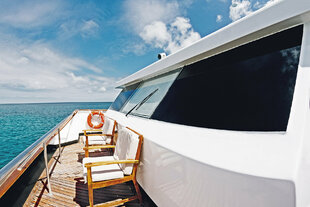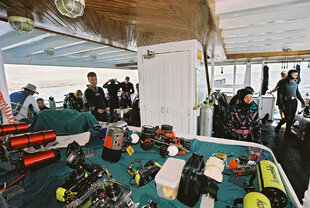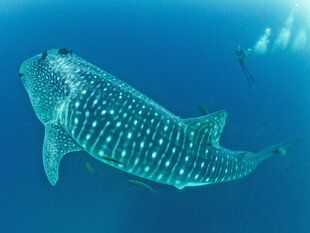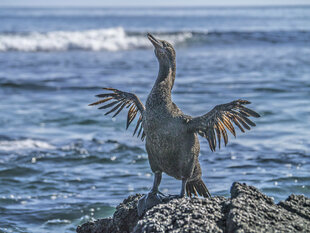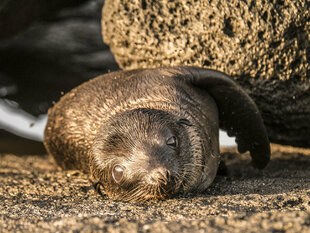Galapagos Sky is a dive boat with 8 cabins – 4 master cabins and 4 deluxe cabins – for 16 passengers launched in 2001 by the builder and president, Santiago Dunn. Master cabins can have a king-size bed or twin beds and large windows whereas deluxe cabins always have twin beds and porthole windows. All cabins are ensuite. Onboard, there is a sun deck with day beds, chaise longues and hammocks, a spacious lounge with Apple TV and pre-loaded films, ideal for presentations and dive briefings, a library and a bar. Free Wi-Fi is also offered onboard. The yacht, as well as great diving experiences, comes with great accommodation, excellent food and a helpful and friendly onboard staff and crew.
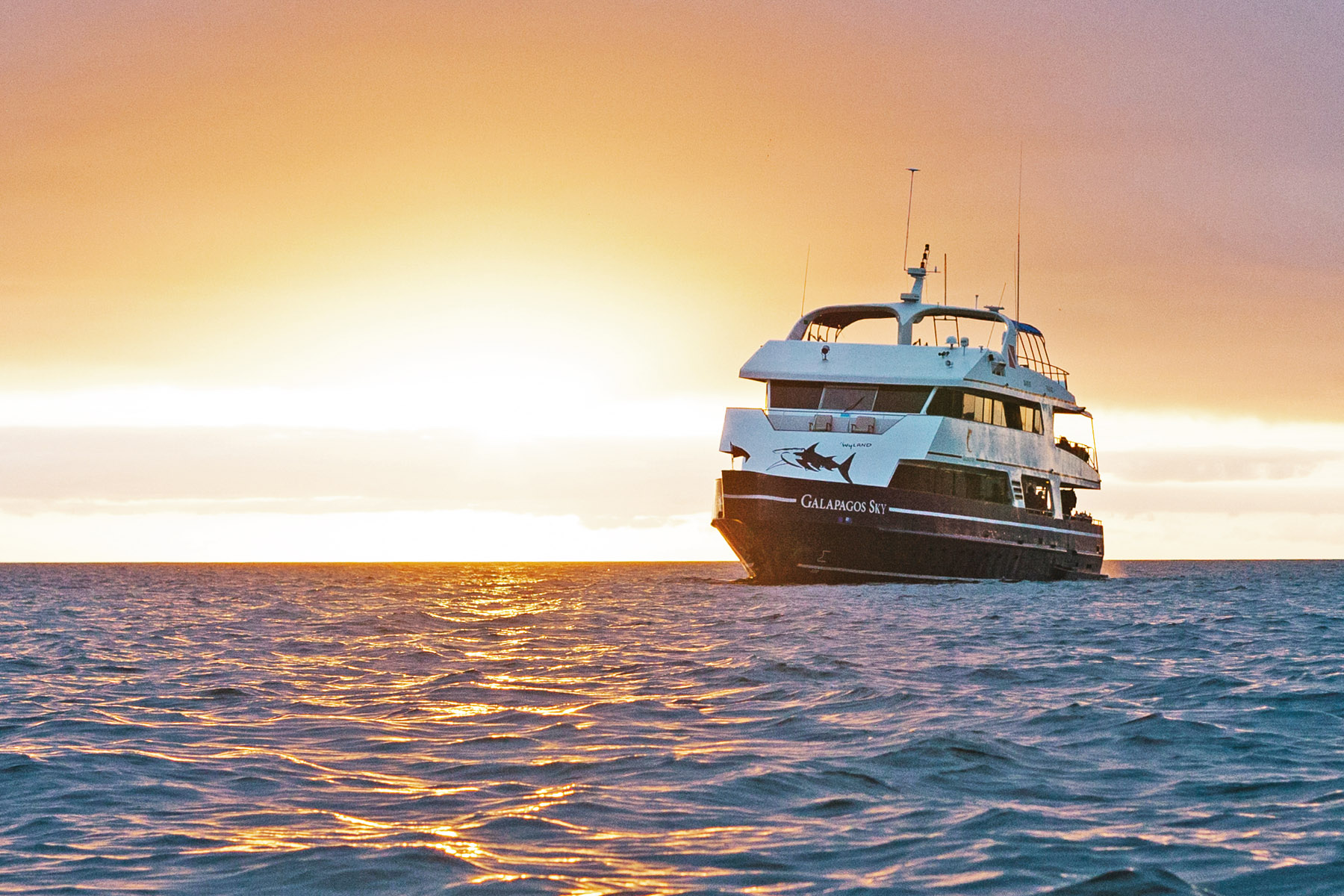
There are 11 experienced Ecuadorian crew members onboard, including a captain, two expert naturalist guides / Dive Masters (1 per 8 divers).
All meals and snacks aboard are included in the cruise rate, with menus using locally sourced ingredients and cooked by culinary school trained chefs. Depending on your dive schedule, either a full breakfast will be served first thing in the morning or there will be a light continental breakfast before a dive before a full breakfast afterwards. Dinner orders are taken in the morning and snacks provided throughout the day. Meals are of Ecuadorian and international cuisine. Dietary requirements can be met but Kosher requests must be received 60 days prior to departure.
Solo travellers can book a twin room on a same gender share basis to avoid single supplement.
Included in the price are meals, snacks, beer, wine, spirits, liquors, dive tanks, weights, weight belts and activities onboard the boat and in the itinerary.
It is possible to rent some gear onboard, but it is not possible to rent cameras, gloves, hoods, thermal vests, torches/underwater lights, knives, steel tanks or pony bottles onboard.
Diving, Wildlife & Photography
The primary focus of the trips offered on this boat is diving with marine life in the Galapagos. You will be swimming in the waters of Wolf and Darwin Islands, known for their abundance of sharks like Hammerheads and White-Tips – even Whale Sharks in the right season. It is also common to see Turtles, schools of Tuna, Eagle Rays and Sealions.
There are plenty of opportunities for underwater photographers on these itineraries, not only for marine life already mentioned, but also of complex and unique underwater rock formations. There are great subjects for macro photographers, with opportunities for shots of Sea Horses, Barnacle Blennies and Coral Hawkfish among others.
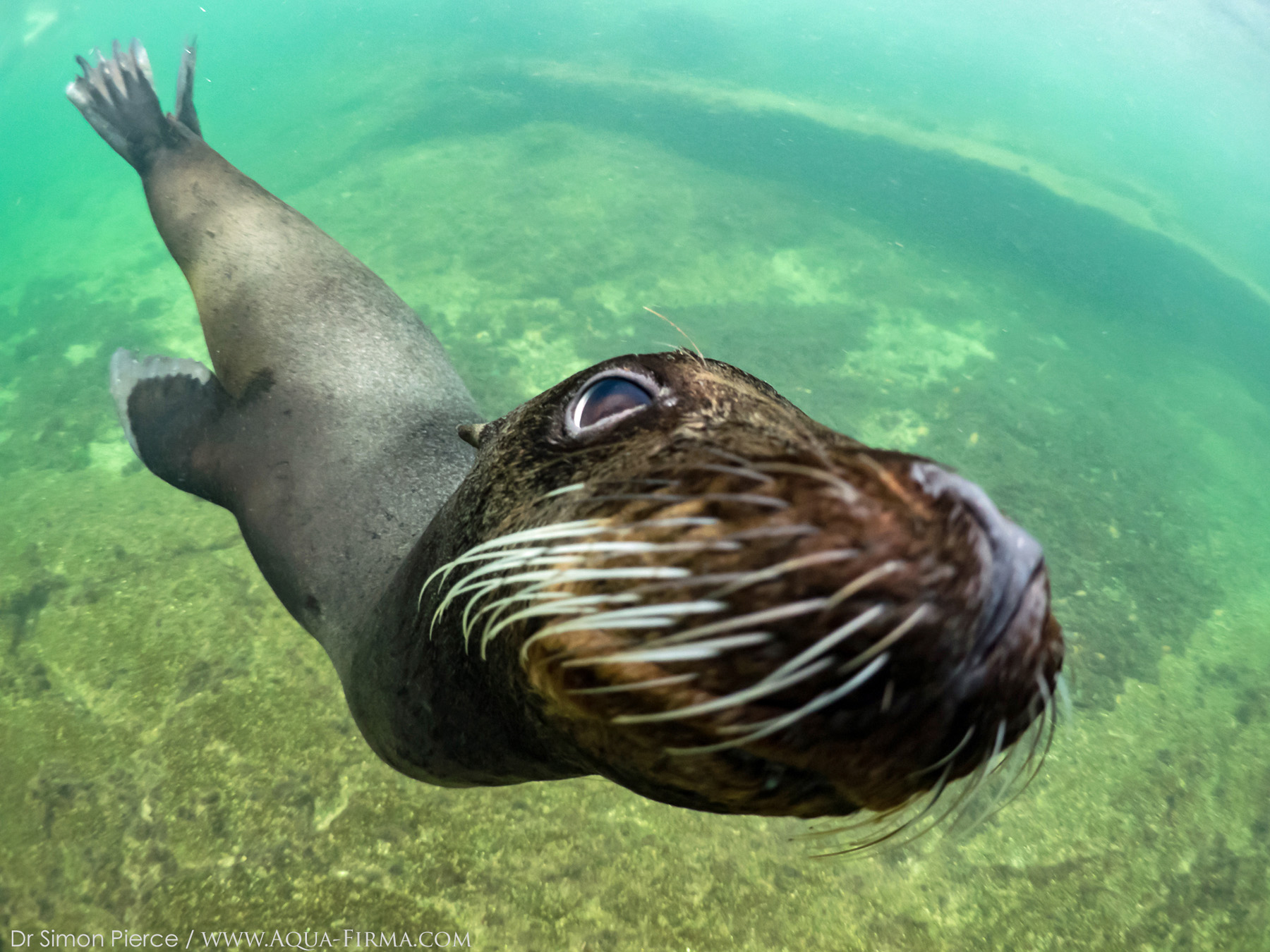
Although the diving in the Galapagos gives a brilliant experience of the archipelago, there are many opportunities to explore more of the islands above the water. This ship does include some activities above water but if you would like to explore more of the Galapagos Islands through land-based excursions, you could consider adding more time to your stay by choosing an experience from our Galapagos page.
Technical Specifications
| Length | 100 ft / 30 m |
| Beam | 24 ft / 7.3 m |
| Cabins | 8 ensuite (4 master, 4 deluxe) |
| Guest capacity | Maximum 16 |
| Crew | 11 |
| Communications | Free Wi-Fi for WhatsApp calls & emails |
| Construction | 2001 |
| Hull material | Steel |
| Top speed | 12 knots |
| Fuel capacity | 7,500 gallons |
| Water capacity | 3,500 gallons |
| Desalinator production | 4,500 gallons per day |
| Compressors | 2 high & 2 low pressure |
| Electricity | 110V & 220V plug type B outlets (US) |
Deck Plan
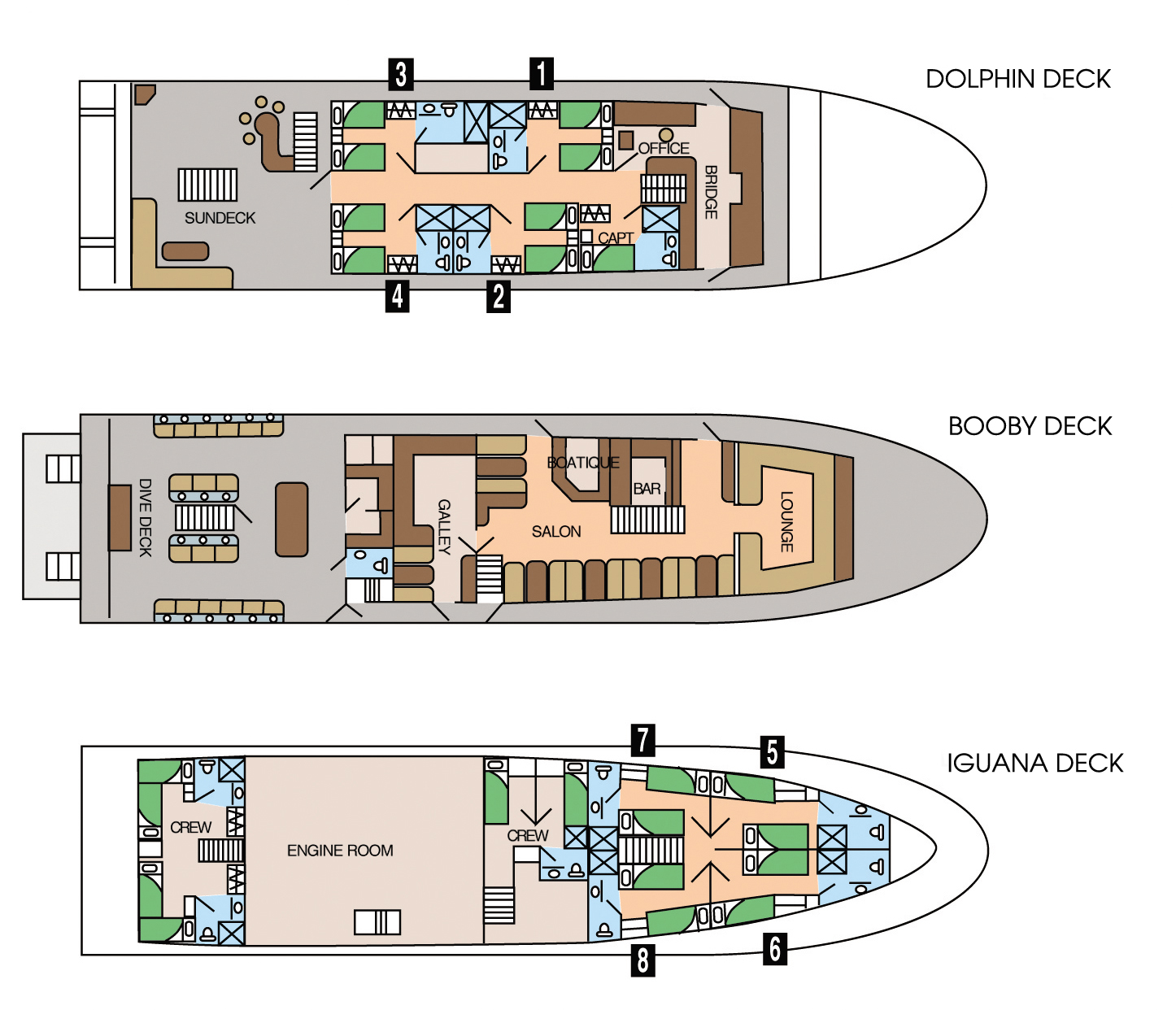
Itinerary
Please note that these itineraries are subject to change without notice due to seasonal changes, last minute weather conditions and the decision of the Galapagos National Park authority.
Day 1 (Sunday)
AM: Arrival, San Cristobal or Baltra
If you are landing at San Cristobal Airport, you will be directed towards the airport terminal building. You will need to queue here to pay your Galapagos National Park fee and have your luggage inspected for potential contaminants to the island, such as plant matter or seeds.
Please wait for you baggage to be unloaded. Collect it and then look for someone holding a card with your name or the name of your Galapagos yacht: Galapagos Sky.
If you are landing at Baltra Airport, you will pass through an airport inspection point to make sure that no foreign plants or animals are introduced to the islands, and to pay the park entrance fee of $200 (unless it has been prepaid). A guide will meet you, help you collect your luggage and escort you on a short bus ride to the harbour.
PM: Navigation to Isla Lobos or Mosquera
If you boarded the boat after landing at San Cristobal Airport, the boat will sail to Isla Lobos. The beach on Lobos Island harbours a colony of Galapagos sea lions. As in other colonies in the archipelago, you can approach nurturing females within a few metres. In the breeding season this colony is also visited by territorial males, defending and mating the harem on their section of beach. This low islet is home to more than just Galapagos sea lions. Two other emblematic species breed here: male blue-footed boobies and great frigate birds. In season, booby males try to impress females with clumsy dances, showing off how blue (and healthy) their feet are. Male frigatebirds inflate and wobble huge red throat poaches called gulas. Young fluffy offspring cry for food, whilst juveniles try out their wings ready to fly. You will have your check-out dive here today.
If you boarded the boat after landing at Baltra Airport, the boat will sail to Mosquera. Mosquera is a low white sand island which lies in the Itabaca Channel between Baltra Island (South Seymour) and North Seymour. It is surrounded by coral reefs, providing protected conditions for snorkelling and scuba diving. Above water, it has a large sealion colony and is good for spotting birds like America oyster catchers, blue-footed boobies and lava gulls. You will have your check-out dive here.
Day 2 (Monday)
AM: North Seymour Island
North Seymour is an uplifted island of lava flow lying just to the north of Santa Cruz Island. There are five dive sites here suitable for all levels of divers, although sometimes the currents can be strong. There is a considerable variety of species here. We can see cleaning behaviour, a large garden eel colony, sea turtles, sea lions, fur seals, eagle rays, yellow-tailed grunts, big-eyed jack, and frequently white tip reef sharks. Occasionally, Hammerheads and Galapagos Sharks can also be seen here. Beautiful blue nudibranchs can be found on some rocks in great abundance. Don't be surprised if a sealion appears before you beneath the water. Better still, we often anchor in a bay between dives where snorkelling with sealions often excellent, with long and playful encounters. All this whilst beside us is a rocky cliff covered in sea birds such as blue footed boobies.
PM: Cousins Rock, Santiago Island
This will be where you will begin your proper diving for this itinerary and there will be 2 here this afternoon. Cousins Rock dive site is characterised by its sloping rock formation which is home to many reef-dwelling marine animals such as Seahorses, Octopus, Sharks, Sea Lions and Green Turtles.
Days 3 & 4 (Tuesday & Wednesday) – Wolf Island
You will have multiple dives at various sites off Wolf Island over these 2 days – 3 daytime dives and a night dive on Tuesday followed by 4 daytime dives on Wednesday.
Wolf Island is one of our planet’s most incredible dive locations. It is actually made up of two volcanic islands with a sheltered bay which you might share with a Sea Shepherd monitoring boat.
This is a good spot to see Red-Lipped Batfish which 'walk' along the seabed.
Wolf Island itself is one of the best places in the world to dive amongst sharks. This includes schooling hammerheads, Galapagos sharks, silky sharks, white tip sharks amongst the cliffs and caverns and sometimes whale sharks. Spotted eagle rays are another delight here and huge numbers of fish filling the water.
Days 5 & 6 (Thursday & Friday) – Darwin Island
These 2 days will be spent diving at sites off Darwin island – 4 daytime dives for each day.
Darwin Island is a high, relatively flat-topped island which is impossible to land on since it is sheer cliff all around. Thousands of birds live on the island, including Nazca Boobies and Frigate Birds. In addition to the island, Darwin's Pillars (formerly an arch) is a dramatic feature offshore; and many of your dives will be close to this point. Again, it is impossible to land here safely, but there is a colony of sealions which you will see from a distance living beneath the Arch.
The marine life is usually spectacular here with many sharks, especially hammerheads, which can swim very close. There are also lots of Porites coral bommies, so please avoid touching these. Between June and October / November, you will have good chances of seeing whale sharks here, including some huge females measuring up to about 15 metres.
Day 7 (Saturday)
There will be the final 2 dives at Darwin Island and the final dive at Wolf Island of the itinerary today.
Day 8 (Sunday)
AM: Cabo Douglas, Fernandina Island
There is some great wildlife to see at Cape Douglas, including Flightless Cormorants, Galapagos Penguins and Marine Iguanas. Beneath the waves you can hope to see Red-Lipped Batfish, Galapagos Bullhead Sharks and Mola-Mola. It is sometimes possible to see baleen whales at this site too. Diving here should be great for Marine Iguana encounters, as well as underwater volcanic formations.
PM: Punta Vicente Roca, Isabela Island
There are great underwater opportunities at Vicente Roca Point thanks to upwelling cold-water currents here. Marine life in the area includes various shark species, Galapagos Penguins, Seahorses & Mola-Mola. Other animals which you can hope to see here are Nazca & Blue-Footed Boobies, Brown Pelicans & Flightless Cormorants. A Panga ride after your dive will give you the site’s best opportunities for photographing Galapagos Penguins, Flightless Cormorants and Blue Footed Boobies.
Day 9 (Monday)
AM: Cabo Marshall, Isabela Island
Cape Marshall in on the north-east side of Isabela and is home to a few great diving spots. In these dive locations, it is easiest to drift dive across a black coral-coated vertical wall descending to the seabed where Hammerhead, White-Tipped & Galapagos sharks can be spotted. Even Whale Sharks have been seen here. Other marine life includes large schools of Black-Striped Salema and Barracuda.
PM: Roca Blanca, Isabela Island
This site is off the southeast of Isabela Island. It is rarely visited and pristine, often providing opportunities to see Giant Manta Rays, Whitetip & Hammerhead Sharks and Sea Turtles. There is also dramatic topography here too, with a wall rich is life and black coral.
Day 10 (Tuesday)
AM: Pinzon Island
Pinzón Island is 6.9 miles2 (18 km2) and has no permanent human population. There are Galapagos Tortoises and Sea Lions on the island. The dive site at Pinzón is called No Name Rock, an islet which you can dive all the way around and potentially see Hammerhead Sharks, Rays and Turtles.
PM: Highlands, Santa Cruz Island
The road to the highlands leaves from Bellavista, a small village located a 15-minute drive from Santa Cruz’ main town of Puerto Ayora. The road passes through the Galapagos’ most productive agricultural zone, up to the National Park boundary. We find Miconia vegetation at this altitude, changing to the Fern and Sedge zone as we ascend further. With clear weather, we can enjoy beautiful scenes of rolling hills and extinct volcanic cones covered with grass and lush greenery all year round. In the Highlands is El Chato Reserve, where Giant Galapagos Tortoises can be observed in the wild – the iconic species which gave the Galapagos Islands their name. Other species to see at this reserve include Short-Eared Owls, Yellow Warblers & Finches. More elusive species which can be difficult to spot here are Galapagos Rails & Paint-Billed Crakes.
Day 11 (Wednesday)
AM: Departure, San Cristobal or Baltra
If you disembark at San Cristobal Island, you will visit the Interpretation Centre and UMAMI restaurant. The San Cristóbal Interpretation Centre just outside the provincial capital of Puerto Baquerizo Moreno, is a perfect complement to the field explanations and briefings of your naturalist guide and host. Information panels are in English and Spanish, with many photographs, models and true to life dioramas which tell the background story of the islands in different ways. They really capture what makes the Galapagos Islands so unique. The well-maintained botanical garden with native species from the arid zone (including the giant prickly pear and candelabra cacti) is worth your visit as well; and you will probably spot the Chatham Mockingbird which is endemic to this island - a bird which put Darwin on track to his theory of evolution. The attractive exhibition is quite complete and explains a series of natural circumstances that create the Galapagos’ unique environment: such as the volcanic genesis of the islands, their remoteness from the continent, its ocean currents, its special climate, the arrival of different species, and their establishment, among others. It also recounts historic discovery and attempts of colonisation; and shows a diorama with ancient mail barrels from Post Office Bay.
Your guide and some crew members will accompany you back to San Cristobal where you will take the airport shuttle. Your guide will remain with you through check-in counters & the departure hall.
If you depart at Baltra Island, you will go directly to the airport after breakfast onboard. Your guide & some crew members will go with you to Baltra where you will board the airport shuttle. Your guide will remain with you through the check-in counters & departure hall.
Day 1 (Sunday)
AM: Arrival, San Cristobal Island
Land at San Cristobal airport where you will be directed towards the airport terminal building. You will need to queue here to pay your Galapagos National Park fee and have your luggage inspected for potential contaminants to the island, such as plant matter or seeds.
Please wait for you baggage to be unloaded. Collect it and then look for someone holding a card with your name or the name of your Galapagos yacht: Galapagos Sky
PM: Check-Out Dive, Isla Lobos
The beach on Lobos Island harbours a colony of Galapagos sea lions. As in other colonies in the archipelago, you can approach nurturing females within a few metres. In the breeding season this colony is also visited by territorial males, defending and mating the harem on their section of beach. This low islet is home to more than just Galapagos sea lions. Two other emblematic species breed here: male blue-footed boobies and great frigate birds. In season, booby males try to impress females with clumsy dances, showing off how blue (and healthy) their feet are. Male frigatebirds inflate and wobble huge red throat poaches called gulas. Young fluffy offspring cry for food, whilst juveniles try out their wings ready to fly.
Day 2 (Monday)
AM: North Seymour Island
North Seymour is an uplifted island of lava flow lying just to the north of Santa Cruz Island. There are five dive sites here suitable for all levels of divers, although sometimes the currents can be strong. There is a considerable variety of species here. We can see cleaning behaviour, a large garden eel colony, sea turtles, sea lions, fur seals, eagle rays, yellow-tailed grunts, big-eyed jack, and frequently white tip reef sharks. Occasionally, Hammerheads and Galapagos Sharks can also be seen here. Beautiful blue nudibranchs can be found on some rocks in great abundance. Don't be surprised if a sealion appears before you beneath the water. Better still, we often anchor in a bay between dives where snorkelling with sealions often excellent, with long and playful encounters. All this whilst beside us is a rocky cliff covered in sea birds such as blue footed boobies.
PM: Cousins Rock, Santiago Island
Cousins Rock dive site is characterised by its sloping rock formation which is home to many reef-dwelling marine animals such as Seahorses, Octopus, Sharks, Sea Lions and Green Turtles.
Day 3 (Tuesday) – Wolf Island
You will have 3 daytime and 1 night dive at various sites off Wolf Island.
Wolf Island is one of our planet’s most incredible dive locations. It is actually made up of two volcanic islands with a sheltered bay which you might share with a Sea Shepherd monitoring boat.
This is a good spot to see Red-Lipped Batfish which 'walk' along the seabed.
Wolf Island itself is one of the best places in the world to dive amongst sharks. This includes schooling hammerheads, Galapagos sharks, silky sharks, white tip sharks amongst the cliffs and caverns and sometimes whale sharks. Spotted eagle rays are another delight here and huge numbers of fish filling the water.
Day 4 (Wednesday) – Darwin Island
You will have 4 daytime dives at various sites off Darwin Island.
Darwin Island is a high, relatively flat-topped island which is impossible to land on since it is sheer cliff all around. Thousands of birds live on the island, including Nazca Boobies and Frigate Birds. In addition to the island, Darwin's Pillars (formerly an arch) is a dramatic feature offshore; and many of your dives will be close to this point. Again, it is impossible to land here safely, but there is a colony of sealions which you will see from a distance living beneath the Arch.
The marine life is usually spectacular here with many sharks, especially hammerheads, which can swim very close. There are also lots of Porites coral bommies, so please avoid touching these. Between June and October / November, you will have good chances of seeing whale sharks here, including some huge females measuring up to about 15 metres.
Day 5 (Thursday)
AM: Darwin Island
There will be the final 2 dives at Darwin Island of the itinerary this morning.
PM: Wolf Island
You will have one last dive off Wolf Island this afternoon.
Day 6 (Friday)
AM: Cabo Douglas, Isabela Island
There is some great wildlife to see at Cape Douglas, including Flightless Cormorants, Galapagos Penguins and Marine Iguanas. Beneath the waves you can hope to see Red-Lipped Batfish, Galapagos Bullhead Sharks and Mola-Mola. It is sometimes possible to see baleen whales at this site too. Diving here should be great for Marine Iguana encounters, as well as underwater volcanic formations.
PM: Punta Vicente Roca, Isabela Island
There are great underwater opportunities at Vicente Roca Point thanks to upwelling cold-water currents here. Marine life in the area includes various shark species, Galapagos Penguins, Seahorses & Mola-Mola. Other animals which you can hope to see here are Nazca & Blue-Footed Boobies, Brown Pelicans & Flightless Cormorants. A Panga ride after your dive will give you the site’s best opportunities for photographing Galapagos Penguins, Flightless Cormorants and Blue Footed Boobies.
Day 7 (Saturday)
AM: Pinzon Island
Pinzón Island is 6.9 miles2 (18 km2) and has no permanent human population. There are Galapagos Tortoises and Sea Lions on the island. The dive site at Pinzón is called No Name Rock, an islet which you can dive all the way around and potentially see Hammerhead Sharks, Rays and Turtles.
PM: Highlands, Santa Cruz Island
The road to the highlands leaves from Bellavista, a small village located a 15-minute drive from Santa Cruz’ main town of Puerto Ayora. The road passes through the Galapagos’ most productive agricultural zone, up to the National Park boundary. We find Miconia vegetation at this altitude, changing to the Fern and Sedge zone as we ascend further. With clear weather, we can enjoy beautiful scenes of rolling hills and extinct volcanic cones covered with grass and lush greenery all year round. In the Highlands is El Chato Reserve, where Giant Galapagos Tortoises can be observed in the wild – the iconic species which gave the Galapagos Islands their name. Other species to see at this reserve include Short-Eared Owls, Yellow Warblers & Finches. More elusive species which can be difficult to spot here are Galapagos Rails & Paint-Billed Crakes.
Day 8 (Sunday)
AM: Interpretation Centre & UMAMI Restaurant, San Cristobal Island
The San Cristóbal Interpretation Centre just outside the provincial capital of Puerto Baquerizo Moreno, is a perfect complement to the field explanations and briefings of your naturalist guide and host. Information panels are in English and Spanish, with many photographs, models and true to life dioramas which tell the background story of the islands in different ways. They really capture what makes the Galapagos Islands so unique. The well-maintained botanical garden with native species from the arid zone (including the giant prickly pear and candelabra cacti) is worth your visit as well; and you will probably spot the Chatham Mockingbird which is endemic to this island - a bird which put Darwin on track to his theory of evolution. The attractive exhibition is quite complete and explains a series of natural circumstances that create the Galapagos’ unique environment: such as the volcanic genesis of the islands, their remoteness from the continent, its ocean currents, its special climate, the arrival of different species, and their establishment, among others. It also recounts historic discovery and attempts of colonisation; and shows a diorama with ancient mail barrels from Post Office Bay.
PM: Departure, San Cristobal Island
Your guide and some crew members will accompany you back to San Cristobal where you will take the airport shuttle. Your guide will remain with you through check-in counters & the departure hall.
Dates
There is a $200 discount on cabin rate for: divers of 62 years and older at the time of travel, active / current dive instructors and active or retired military personnel.
Discounts cannot be combined. When multiple discounts are applicable, the one of greatest value to the guest will be applied.
Included
Accommodation onboard
All meals, snacks & beverages (including open bar) onboard
One 80 ft3 / 12L tank, weights & weight belt
Up to 4 dives per day on 5.5 days for 7-night cruises
3 land excursions
Service of dive guides
Transfers in the Galapagos between airport & dock (on cruise departure dates only)
All other Galapagos Sky services & amenities
Excluded
Trip interruption or cancellation insurance
Dive Accident Insurance (DAN or DiveAssure)
International airfare to Ecuador (Quito UIO or Guayaquil GYE)
Domestic airfare to Galapagos Islands (Quito UIO or Guayaquil GYE to San Cristobal SCY)
Transit Card ($20)
Hyperbaric chamber fee ($35)
Nitrox ($200)
Rental gear
Gratuities to guides & crew
Fuel surcharge ($150)
Single Supplement
Guests can share a deluxe cabin with another guest of the same gender or can book one for themselves with a 65% supplement for deluxe cabins or an 85% supplement for master cabins between November & June and 100% between July & October. Master cabins cannot be booked to share if deluxe spaces are available until 2 weeks prior to departure. Single supplements are 100% on group bookings or full charters regardless of cabin type.



